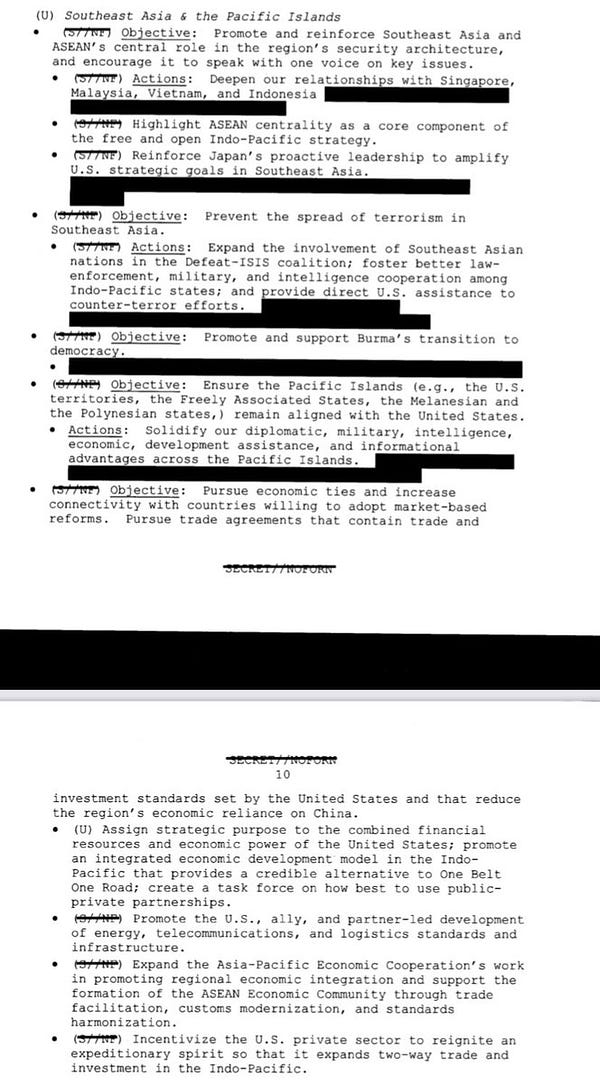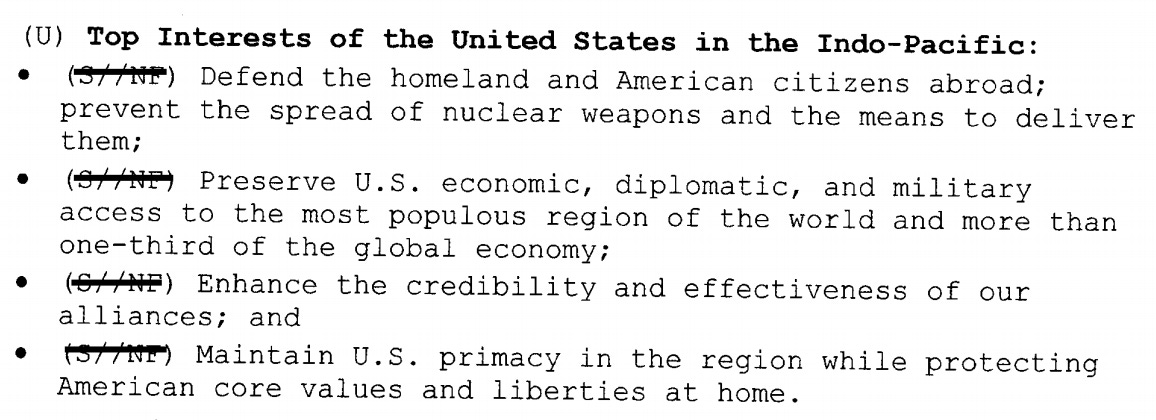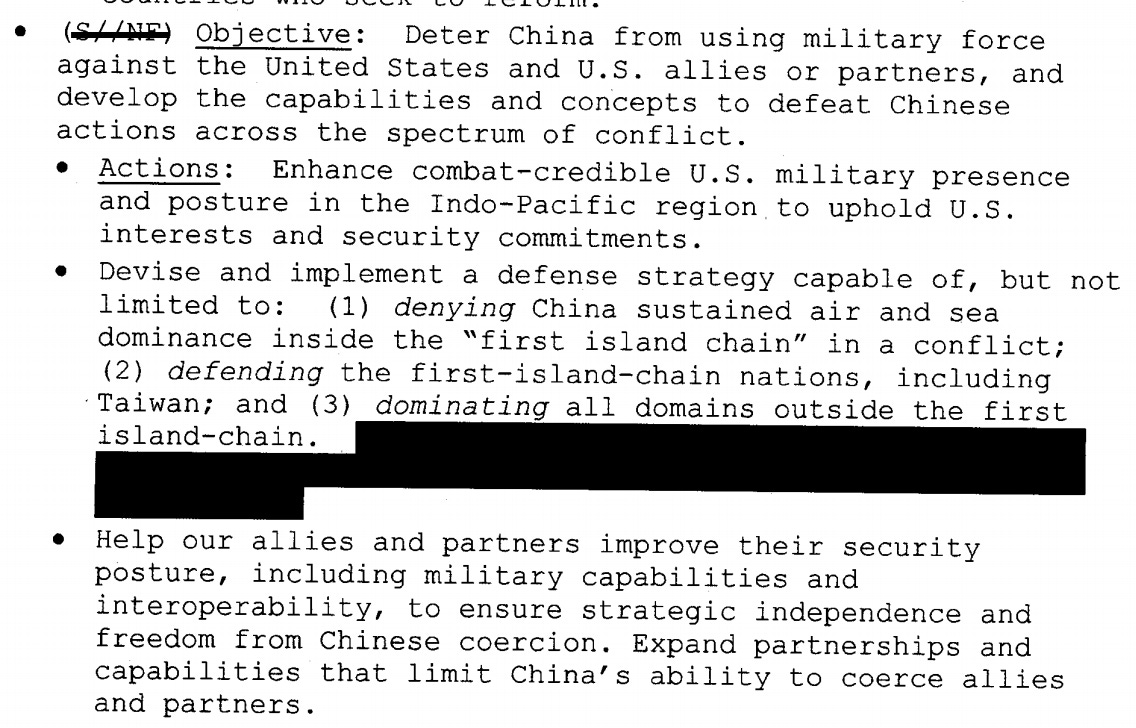Welcome to another issue of Blunt Reentry.
Today’s agenda isn’t pre-planned, but rather presented itself. Axios’ Bethany Allen-Ebrahimian and Zach Dorfman reported on the Trump administration declassifying its framework for the Indo-Pacific region, which caught my eye, of course.
Let’s dig in.


First things first: the redacted PDF of the document—if you’re as much of a fan of primary sources as I am—is available courtesy of the White House here.
As we learn from the document’s declassification review and footer, it was originally classified by former Deputy National Security Adviser Matt Pottinger and declassified by Robert C. O’Brien, the current U.S. national security adviser, on January 5, 2021. Pottinger resigned the after the insurrection in Washington, DC.
There are a few things to be said about this document. Above all, much of what’s contained here is unsurprising and rather obvious from simply observing how the Trump administration went about the conduct of Asia policy over the last four years. There are welcome moments of candidness. For instance, I found the following four bullet points—summarizing the “Top Interests of the United States in the Indo-Pacific”—as a nice distillation of what most Americans mean when they talk about the importance of a “liberal international order” in Asia.
That’s not meant to be a jab at the Trump administration. These points are shockingly banal and consistent across several administrations; they just don’t make for particularly persuasive speechwriting inclusions for, say, the ASEAN summits or the Shangri-La Dialogue. The United States is in it for the long-haul in Asia, primarily for self-interested reasons and not altruistic ones.
We learn also at the outset of the document that the Trump administration saw North Korea as the second most important question to be dealt with in Asia after the issue of promoting a “liberal economic order while preventing China from establishing new, illiberal spheres of influence.” A review of the last four years would probably support that sequencing of priorities. But on both North Korea and China, the document offers nothing but banalities. For instance, the top strategic objective for North Korea is laughably stated as: convincing “the Kim regime that the only path to its survival is to relinquish its nuclear weapons.” Well, that hasn’t gone very well at all, has it?
The set of objectives the Trump NSC had set out for itself on China begin with economic competition—reining in “unfair trading practices”—before moving on to security matters. That, again, supports the sequencing we‘ve seen in practice from the outgoing administration. There’s a considerable bit of dissonance across this document, however, in its professed goal of spreading American and liberal values and the complete lack of any language on human rights. That again isn’t particularly surprising given how the administration has gone about things.
There’s a curious redacted line that follows a three-point set of goals for a defense strategy for East Asia. I have a few speculative thoughts on what this may be and would be curious to hear from readers on what they think may lie behind the black. The point on “dominating all domains outside the first island-chain” is somewhat revealing insofar as it concedes a more modest scope for U.S. operations within the first island chain. U.S. officials don’t easily come around to acknowledging this division too often.
India and Southeast Asia are prominent features of this document—India, especially. I’ve long maintained that the U.S.-India relationship has basically been spared the worst of shocks amid the Obama-Trump transition (exceptions where necessary on trade, GSP, Afghanistan, and Iran sanctions, of course), and this document appears to support that. The Trump NSC set about its work in the Indo-Pacific with one goal being promoting India’s rise and “capacity to serve as a net provider of security and Major Defense Partner.” An “assumption,” stated at the outset, that’s largely unchanged from the second Bush administration is that “a strong India, in cooperation with like-minded countries, would act as a counterbalance to China.” The document does not practically contend with India’s internal changes or New Delhi’s shift in strategic thought—particularly on terrestrial vs. naval defense prioritization—but speaks to the “high hopes” for India that continue to persist in Washington.
Skeptics of the United States in Delhi will be pleased not to see any declassified language promoting a U.S.-India “alliance,” but it's clear as day that the appetite for strategic cooperation with New Delhi remained rather expansive during the Trump administration. As Biden enters the scene, this should persist, but we should expect the new administration to not shy away from uncomfortable conversations with New Delhi about human rights and liberal values.
I’ll close with a few thoughts on Southeast Asia, which I thought was aptly summed up by Indonesian analyst Evan Laksmana on Twitter:


Evan’s view is perfectly understandable. I can’t imagine any self-respecting Southeast Asian strategic analyst reading this document and coming away with anything but a sense of dejection at the continued underappreciation in Washington of the region’s value. The sequencing of objectives reads largely as being unchanged from the latter half of the Obama administration, with terrorism, the democratic transition in Myanmar, and economic connectivity featuring in that order. While ASEAN’s “central role” is alluded to, the discussion of Southeast Asia towards the end of the document alone reveals quite a bit.
I’m glad to have this document available for premature historical analysis of the Trump era in U.S. Asia policy. I don’t think it supports a positive appraisal of the Trump administration’s Asia policy, which may be the hope that Pottinger and O’Brien had leading up to its declassification. In almost every functional and regional area, the administration fell short of its self-stated goals and the desired “end-states” outlined are no closer to materializing. Where the administration stuck to its guns—largely on China—results have been mixed. I don’t credit the Trump administration for the very real shift in global attitudes we’ve seen toward China, but rather Xi Jinping. Either way, views have changed in the United States and elsewhere on the nature of what China represents for the future of the international system.





